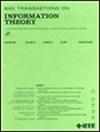Exact Matching in Correlated Networks With Node Attributes for Improved Community Recovery
IF 2.9
3区 计算机科学
Q3 COMPUTER SCIENCE, INFORMATION SYSTEMS
引用次数: 0
Abstract
We study community detection in multiple networks with jointly correlated node attributes and edges. This setting arises naturally in applications such as social platforms, where a shared set of users may exhibit both correlated friendship patterns and correlated attributes across different platforms. Extending the classical Stochastic Block Model (SBM) and its contextual counterpart (Contextual SBM or CSBM), we introduce the correlated CSBM, which incorporates structural and attribute correlations across graphs. To build intuition, we first analyze correlated Gaussian Mixture Models, wherein only correlated node attributes are available without edges, and identify the conditions under which an estimator minimizing the distance between attributes achieves exact matching of nodes across the two databases. For the correlated CSBMs, we develop a two-step procedure that first applies基于节点属性的相关网络精确匹配改进社区恢复
我们研究了具有联合关联节点属性和边的多个网络中的社区检测。这种设置在社交平台等应用程序中自然出现,在这些应用程序中,一组共享的用户可能在不同平台上显示出相关的友谊模式和相关属性。在经典随机块模型(SBM)及其上下文对应模型(contextual SBM或CSBM)的基础上,引入了关联的随机块模型(CSBM),该模型包含了图间的结构和属性关联。为了建立直觉,我们首先分析了相关高斯混合模型,其中只有相关节点属性可用而没有边缘,并确定了最小化属性之间距离的估计器在两个数据库之间实现节点精确匹配的条件。对于相关的csbm,我们开发了一个两步过程,首先使用边缘信息对大多数节点应用k-core匹配,然后通过使用基于距离的估计器利用其属性来改进剩余未匹配节点的匹配。我们确定了算法恢复精确节点对应的条件,使我们能够合并相关边并平均相关属性以增强社区检测。至关重要的是,通过对齐和组合图,我们确定了在单个图中不可能进行社区检测的制度,但当来自相关图的侧信息被合并时,社区检测变得可行。我们的研究结果说明了图匹配和社区恢复之间的相互作用如何提高性能,扩大了多图、基于属性的社区检测的范围。
本文章由计算机程序翻译,如有差异,请以英文原文为准。
求助全文
约1分钟内获得全文
求助全文
来源期刊

IEEE Transactions on Information Theory
工程技术-工程:电子与电气
CiteScore
5.70
自引率
20.00%
发文量
514
审稿时长
12 months
期刊介绍:
The IEEE Transactions on Information Theory is a journal that publishes theoretical and experimental papers concerned with the transmission, processing, and utilization of information. The boundaries of acceptable subject matter are intentionally not sharply delimited. Rather, it is hoped that as the focus of research activity changes, a flexible policy will permit this Transactions to follow suit. Current appropriate topics are best reflected by recent Tables of Contents; they are summarized in the titles of editorial areas that appear on the inside front cover.
 求助内容:
求助内容: 应助结果提醒方式:
应助结果提醒方式:


